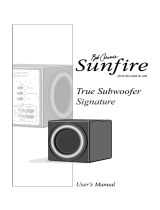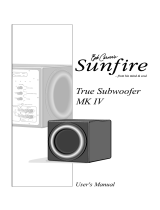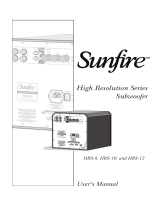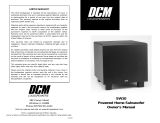Page is loading ...


User's Manual
2
Safety Instructions
1. Read Instructions -– All the safety and
operation instructions should be read
before the Sunfire Component is
operated.
2. Retain Instructions — The safety and
operating instructions should be kept for
future reference.
3. Heed Warnings — All warnings on the
Component and in these operating
instructions should be followed.
4. Follow Instructions — All operating and
other instructions should be followed.
5. Water and Moisture — The Component
should not be used near water - for
example, near a bathtub, washbowl,
kitchen sink, laundry tub, in a wet
basement, or near a swimming pool, etc.
6. Ventilation — The Component should be
situated so that its location or position
does not interfere with its proper ventila-
tion. For example, the Component should
not be situated on a bed, sofa, rug, or
similar surface that may block any
ventilation openings; or placed in a built-in
installation such as a bookcase or cabinet
that may impede the flow of air through
ventilation openings.
7. Heat — The Component should be
situated away from heat sources such as
radiators, or other devices which produce
heat.
8. Power Sources — The Component
should be connected to a power supply
only of the type described in these
operation instructions or as marked on the
Component.
9. Power Cord Protection — Power-supply
cords should be routed so that they are
not likely to be walked upon or pinched by
items placed upon or against them,
paying particular attention to cords at
plugs, convenience receptacles, and the
point where they exit the Component.
10. Cleaning — The Component should be
cleaned only as recommended in this
manual.
11. Non-use Periods—The power cord of
the Component should be unplugged from
the outlet when unused for a long period
of time.
12. Object and Liquid Entry — Care
should be taken so that objects do not fall
into and liquids are not spilled into the
inside of the Component.
13. Damage Requiring Service — The
Component should be serviced only by
qualified service personnel when:
A. The power-supply cord or the plug has
been damaged; or
B. Objects have fallen, or liquid has spilled
into the Component; or
C. The Component has been exposed to
rain; or
D. The Component does not appear to
operate normally or exhibits a marked
change in performance; or
E. The Component has been dropped, or its
cabinet damaged.
14. Servicing — The user should not
attempt to service the Component beyond
those means described in this operating
manual. All other servicing should be
referred to qualified service personnel.

User's Manual
3
15. To prevent electric shock, do not use
this polarized plug with an extension cord,
receptacle or other outlet unless the
blades can be fully inserted to prevent
blade exposure.
Pour préevenir les chocs électriques ne
pas utiliser cette fiche polariseé avec un
prolongateur, un prise de courant ou une
autre sortie de courant, sauf si les lames
peuvent être insérées à fond sans laisser
aucune pariie à découvert.
16. Grounding or Polarization —
Precautions should be taken so that the
grounding or polarization means of the
Component is not defeated.
Safety Instructions ....................................... 2
Introduction .................................................. 4
Features....................................................... 4
Unpacking .................................................... 4
Care ............................................................. 4
Overview ...................................................... 5
Control panel features ................................. 6
Installation .................................................... 8
Connections ................................................. 9
Location ..................................................... 10
System configurations ............................... 11
Adjusting the controls ................................ 15
Specifications............................................. 16
Troubleshooting guide ............................... 17
Limited warranty ........................................ 19
Service assistance ..................................... 19
Contents
To find out more about this and other Sunfire products,
please visit our website: www.sunfire.com
This apparatus does not exceed the Class
A/Class B (whichever is applicable) limits
for radio noise emissions from digital
apparatus as set out in the radio
interference regulations of the Canadian
Department of Communications.
ATTENTION — Le présent appareil
numérique n'émet pas de bruits
radioélectriques dépassant las limites
applicables aux appareils numériques de
class A/de class B (selon le cas)
prescrites dans le règlement sur le
brouillage radioélectrique édicté par les
ministere des communications du
Canada.
WARNING:THIS SUBWOOFER IS CAPABLE OF PRODUCING
SOUND PRESSURE LEVELS IN EXCESS OF 107 dB. YOU
MUST TAKE EVERY PRECAUTION TO PROTECT YOUR
HEARING FROM PERMANENT DAMAGE.

User's Manual
4
Your Sunfire Subwoofer should reach
you in perfect condition. If you do notice
any shipping damage, please contact
your Sunfire Dealer immediately.
Gently lift out the unit and remove all
the packing material. It is important to
save all the packing materials and the
box in case your subwoofer ever needs
to be moved or shipped for repair.
Make sure that you keep your sales
receipt. It is the only way to establish the
duration of your Limited Warranty and it
may come in useful for insurance
purposes.
Please take a moment to fill out and
mail the Sunfire Warranty Registration
card. Also read the serial number located
on the control panel and record it here:
Unpacking
Features
• 1250 watt, high efficiency amplifier
• Very low distortion
• Long throw, premium quality driver
• Extremely compact size
• Automatic signal-sensing turn-on
and standby mode
• Line level inputs
• Speaker-level binding post inputs
• Line level high-pass outputs
• Flat/Video contour switch
• Continuously variable phase
control
• Continuously variable crossover
control, 35 Hz to 100 Hz
• Continuously variable volume level
control
• Soft clipping circuit allows graceful
overload and prevents speaker
damage due to clipping
• Gold-plated inputs and outputs
Dear Friend:
Thank you for purchasing my Sunfire
True Subwoofer Architectural. I hope you
enjoy it and the music it makes as much
as I have enjoyed creating it for you.
The big breakthrough features of the
subwoofer are its uncanny tracking
downconverter and its long throw, high
back-electromotive force driver. Taken
together, they provide this subwoofer
with as much bass as you could get from
several 15 inch drivers mounted in a
cabinet the size of a small refrigerator.
Introduction
Serial Number:
Purchased from:
Date:
Care
To maintain the speaker cabinet’s
finish, first unplug the power cord and
then use a soft, slightly dampened cloth
to clean the surfaces and finish off with a
dry cloth.
To keep the large rubber surrounds
soft and supple for 20 years or more,
treat them with MINK OIL, available at
most shoe repair stores. Rub a generous
amount into the surrounds with a soft
cloth about once a year (more often if
you live in a dry climate).
If your Sunfire Subwoofer needs
servicing, please read the Troubleshoot-
ing section on page 17. If a problem still
persists, contact your nearest authorized
Sunfire Dealer.

User's Manual
5
Your Sunfire Subwoofer is designed to
give you the best possible low-frequency
sound quality for your home theater
experience. It incorporates a tremen-
dously powerful built-in amplifier to
produce tight, floor-rumbling bass down
to 18 Hz, that you can feel as well as
hear.
The subwoofer has an adjustable high
cut filter and speaker level and low level
inputs for easy incorporation into
existing systems, or as part of a
subwoofer/satellite speaker combina-
tion.
The Woofer
To have lots of bass requires moving
lots of air. Your Sunfire True
Subwoofer’s driver can move back and
forth approximately five times more than
a normal subwoofer. This gives it a lot of
air moving capacity which allows for
massive bass performance.
The Amplifier
The large movement range of the
driver creates greater air pressure inside
the box than a conventional woofer.
Therefore, the drive amplifier must be
much more powerful than an ordinary
woofer amplifier. In fact, it has to be so
powerful that it is almost hard to believe.
The power amplifier within your
Sunfire True Subwoofer is capable of
delivering over 1,250 watts into a 3.3
ohm resistor (the voice coil resistance of
the subwoofer’s driver). When the same
full output is applied to the driver,
however, the enormous back-electromo-
tive force generated as a consequence
of its large motion and giant magnet
causes the current flow to be much less
than if it were a 3.3 ohm resistor. It is
this singular property of the driver that
allows the woofer to be approximately
ten times more efficient than a woofer
this size would normally be. Hence, the
actual average input power is substan-
tially less than 1,250 watts, and is
approximately 120 watts for most
musical material on the loudest
passages.
A compressor circuit kicks in automati-
cally if the input signal level reaches a
level that would overload the driver. This
maintains a ceiling on the output without
clipping.
If the input signal is driven even
further, a ‘soft clipping’ circuit is enabled.
This allows the woofer to put more sound
into the room to satiate the power hungry
user, but without distortion or damage to
the woofer. Thus, for explosive scenes in
movies, this produces extremely high
sound pressure levels (SPL) in your
room without the woofer banging against
its mechanical stops.
If you would like more detailed
information regarding the subwoofer
design, please call us and we will send
you a copy of our subwoofer technical
white paper, or you can view it on our
website: www.sunfire.com.
Note: In this manual, the term “sub/
LFE” is used to denote the subwoofer or
Low Frequency Effects output, com-
monly found on home theater preamplifi-
ers and receivers.
Overview

User's Manual
6
1
2
3
4
5
678910
FU
S
E
Control Panel Features
1. Power/Auto on Indicator
This light is bright when the subwoofer
is on, and dim when the subwoofer is
in its standby mode. This is controlled
by the AUTO ON/OFF circuit. The
presence of an audio signal turns the
unit on. After approximately fifteen
minutes of signal absence, the
subwoofer will go to its standby mode.
The light will only go off when the unit
is unplugged from the wall.
2. Bass Level
This volume control lets you match the
output level of the subwoofer to the
level of your satellite/main speakers.
The subwoofer output will increase as
the Bass Level is rotated clockwise.
When you have just installed your
system, turn this down first before
turning on your subwoofer. This will
prevent any loud surprises.
3. Crossover Frequency
This controls the high frequency cutoff
point. With the control rotated fully
clockwise, the subwoofer will repro-
duce frequencies up to 100 Hz. With
the control fully counter-clockwise the
subwoofer reproduces up to 35 Hz.
Rotate the control until the bass
sounds natural. If the mid-bass sounds
natural but you want more low bass,
turn the crossover frequency down a
little, then turn the Bass Level up by
about the same amount. This
increases the low-bass output while
leaving the mid-bass output the same.
4. Phase Control
This control changes the relative phase
of the subwoofer with respect to your
other speakers. Use this control to help
blend the subwoofer with the rest of
your system. This is accomplished by
adjusting the control in small incre-
ments as you listen for the most bass
at your listening position. As a final
trim, readjust the Crossover Frequency
and Bass Level controls after the
phase control has been set.
5. Flat/Video Contour Switch
When this switch is set to FLAT, the
frequency response extends down to
18 Hz. This is the recommended
setting for most audio and video
applications.
When set to Video Contour, a low
frequency roll-off is introduced
commencing below approximately
30 Hz. This setting may be used if your

User's Manual
7
system or neighbors are disturbed by
ultra low bass.
6. High Level Inputs
Under normal conditions, the preferred
connection is through the Line Level
inputs. If this is difficult or not possible
in your system, then you can use the
High Level inputs. Also, if you
experience excessive noise or hum
with the Line Level inputs, often a
simple change to the High Level inputs
will result in a lower background noise
level.
Connect to the speaker-level output of
your amplifier or receiver using
speaker wire (see page 14). They can
accept bare wire, banana, dual-banana
or spade connections.
Your amplifier or receiver MUST
have common grounded outputs,
or it will be damaged if connected
to these High Level inputs.
7. Line Level Inputs
Connect with RCA type patch cords to
the line level outputs of your receiver
or preamp. Here are two examples:
If your preamplifier or receiver has a
single sub/LFE output, connect it to the
subwoofer’s left input jack (see page
11). There is no need to use the
subwoofer’s right input jack.
If you want to run your main/satellite
speakers full range, use a “Y” adapter
at the preamplifier outputs (see page
12). In this way, you can send the
preamplifier’s full-range output signal
to your main amplifier and to the
subwoofer at the same time.
8. High Pass Outputs
Line level high-pass output signals are
available at these jacks. These are
active whenever a signal is present at
the inputs of the subwoofer. The high-
pass crossover is a passive network
with a fixed crossover frequency of
70 Hz and a 6 dB per octave slope.
We recommend using this high-pass
function with main/satellite speakers
that are small and not designed to
reproduce low frequencies. If your
main speakers are capable of
operating full range, then you will not
need to use the high-pass function.
To use the High Pass outputs, connect
the preamp outs of your preamp/
receiver to the subwoofer’s Line Level
inputs using good quality RCA type
patch cords. Then connect a second
patch cord from the subwoofer’s High
Pass outputs to the inputs of your main
amplifier (see page 13). This will allow
your main speakers to operate at
frequencies above 70 Hz and the
subwoofer to operate at frequencies
below 70 Hz.
9. Line Fuse
The subwoofer is supplied with a
conservative 4 amp slow-blow type
fuse to protect the electronics.
Always unplug the power cord
before inspecting or changing the
fuse. Never use a fuse with a
current rating more than 4 amps.
10. Power Cord
Plug into any 120 Volt 60 Hz outlet with
a circuit rating of 8 amps or more (a
typical home circuit is rated at 15
amps).
Never plug the power cord directly
into 220-240 Volts AC as this will
cause catastrophic circuit failure.

User's Manual
8
Installation
Observe the following general
precautions and read the safety
instructions on pages 2 and 3 before
using your Sunfire Subwoofer.
• Never open the cabinet or remove
the metal control panel as this
might result in an electrical shock
to you or damage to the unit.
• Protect it from prolonged exposure
to direct sunlight and other direct
sources of heat, such as heating
vents and radiators.
• To prevent fire or shock, do not
expose the unit to rain or moisture.
If fluid or a foreign object should
enter the unit, immediately turn off
the power and contact your Sunfire
Dealer.
• Avoid excessive exposure to
extreme cold or dust.
• Do not place heavy objects on top
of the unit.
• Do not place the subwoofer with its
control panel against the floor.
Heat rise
• Allow adequate ventilation around
the metal control panel of the
subwoofer.
• Do not let anything come into
contact with the panel and keep at
least two inches away from any
walls.
The metal control plate serves as the
amplifier heat sink and also as a conduit
to remove internal heat to the outside
and into the atmosphere. It can reach
temperatures of 60 degrees C, which will
feel hot to the touch, using nerves of
flesh and blood as temperature sensors.
As uncomfortable as it may feel, 60
degrees C cannot burn you, and in fact is
almost cool to copper, silicon, steel, and
aluminum, the materials from which your
woofer is constructed.
AC Power Considerations
Ensure that the unit is plugged into an
outlet capable of supplying the correct
voltage specified for your model.
Unplug your subwoofer’s power cord
from the electrical outlet if it will be left
unused for a long period of time.
NOTE: Never remove the ground
pin from any power cords. This is
very dangerous.
Route the power-supply cord so it is
not likely to be walked on or pinched by
items placed upon or against it,
especially at plugs, convenience
receptacles, and the point where it exits
from the unit.
Magnetic Fields
We recommend that you place your
woofer further than two feet away from
your TV, VCR, tape deck or computer,
so the speaker’s magnet won’t distort the
colors of your TV picture or erase your
video tapes, audio tapes or computer
discs.

User's Manual
9
Please consider the following when
setting up your new system :
• Before making or changing any
connections, ALWAYS make sure
that the subwoofer is unplugged
from the wall and your other
components are turned OFF. Also
turn down the volume control of the
subwoofer and your preamplifier or
receiver.
• This diagram shows all the low
power components sharing a power
strip which is connected to the
same outlet used by the amplifier.
• The subwoofer is connected to an
outlet on the same circuit breaker,
provided that the total system
current draw does not exceed the
circuit breaker current rating.
• This arrangement will reduce the
possibility of an audible hum in your
system caused by a ground loop.
• Whenever possible, keep the
powercords away from the signal
cables or speaker wires to prevent
any hum or interference being
heard in the speakers.
• Choose reliable, high quality
interconnect cables, also called
patch cords or RCA cables. They
should be fully shielded and as short
as possible for the job. The longest
cable in your system will likely be
to the subwoofer, so choose a
good quality brand.
• Some patch cords can be a very
tight fit and there is usually a
preferred method of getting them
off. Some have to be removed with
a twisting action. Be gentle or you
may damage the jacks of the
subwoofer or your other compo-
nents.
Speaker Level connections
• The subwoofer’s Speaker Level
inputs can accept speaker wires
with banana, dual-banana, bare
wire or spade terminals. If you
have banana type connectors on
your speaker wire, make sure that
you tighten the binding posts
before inserting.
• Make sure that the negative
speaker wires never touch the
positive wires as this will short out
and possibly damage your amplifier
or receiver.
The subwoofer’s two negative
posts are joined internally
(common-grounded). Your
amplifier must also be internally
common-grounded or you cannot
use this connection. Contact the
manufacturer of your amplifier to
make sure its outputs are common
grounded.
Tape Deck
DVD
Preamplifier
Power strip
Subwoofer
Amplifier
AC outlets on the same circuit breaker
Connections

User's Manual
10
Location
Placing your Sunfire Subwoofer in a
corner of your room will produce
optimum performance. Experiment with
at least two corners and then decide
which is the best.
Although low frequencies are non-
directional, factors such as room
reflections, standing waves, resonance
and absorption strongly affect your
subwoofer’s performance.
Moving the subwoofer from one corner
to another can have a major effect on the
bass response.
Remember to keep it at least
two or three feet away from
any TV screen, computer,
VCR or magnetic tapes and
discs. This will reduce the chance of the
magnetic fields upsetting the TV screen
or erasing your magnetic media.
Also position the control panel so that
it is not touching anything and can
receive good ventilation.
Using Two Subwoofers
If you wish to use two woofers, the
sound output will double (an increase of
6 dB). Locate the woofers with one in
each corner and experiment with the
location and phase control to achieve the
best bass response.
Always drive each woofer through the
Left/Mon input even though you are
driving one woofer with a right channel
drive and the other with a left channel
drive. If your preamplifier has a single
sub/LFE output, use a Y cable to split it
into two outputs.

User's Manual
11
PREAMPLIFIER
MAIN
OUTPUTS
R
SUB/LFE OUT
R
L
L
AMPLIFIER
INPUTS
TO FRONT SPEAKERS
System Configurations
The following pages show some typical
connections that you might make in your
installation. They show how the inputs
and outputs of the Sunfire Subwoofer are
connected to your preamplifier or
receiver.
If your preamplifier has a
subwoofer output (often
labeled LFE for Low
Frequency Effects), it can
be connected to the
subwoofer’s Left (Mono)
input as shown. This is the
simplest and recom-
mended connection. A
receiver with a sub/LFE
output can be connected in
the same way.
The subwoofer will play
the low frequency range
and the other speakers will
play the frequency range
delivered to them by your
amplifier.
If you have a home
theater preamplifier, it may
have an independent
subwoofer volume and
crossover control. Make
sure this is correctly
adjusted, and that the
Sunfire Subwoofer’s
crossover frequency is set
to 100 Hz. This is by no
means an iron-clad rule,
rather it is a good starting
point. (See the crossover
frequency control details
on page 6 and adjustments on page 15).
You can set the subwoofer’s Bass
Level control to 0dB, and then use the
preamplifier’s subwoofer level control for
normal and routine adjustments.
Connections to a preamplifier’s subwoofer output

User's Manual
12
PREAMPLIFIER
MAIN
OUTPUTS
R
R
L
L
AMPLIFIER
INPUTS
TO FRONT SPEAKERS
PREAMPLIFIER
R
L
AMPLIFIER
Y CABLES
INPUTS
If your preamplifier does
not have a sub/LFE output,
you can use “Y” cables to
send its main outputs to
both the subwoofer and
your amplifier.
The subwoofer will play
the low frequency range
and your front speakers will
play the full range.
Although bass is
commonly distributed
evenly between left and
right channels (L+R bass),
movie soundtracks often
contain differential (L-R)
bass. The opening scene in
“Top Gun”, for example,
has loads of L-R bass
information. If this is not
preserved, the bass in
these scenes sounds
anemic. The Sunfire
Subwoofer utilizes
differential gain on the left
and right inputs to retain
both the L+R and L-R
information. Therefore,
systems which do not have
a dedicated sub/LFE output
should use both the left
and the right inputs as
shown, for the greatest
bass impact.
An alternative connection method
without using Y cables is shown on the
next page.
If your preamp/receiver has a
dedicated sub/LFE output, then only the
Left (Mono) input is used, as shown on
the previous page.
Connections to a preamplifier using Y cables

User's Manual
13
If you are using a
receiver or preamplifier
which does not have a
sub/LFE output, you can
send its left and right front
output into the subwoofer’s
Line Level inputs and then
connect the subwoofer’s
High-Pass outputs to the
inputs of your amplifier.
The subwoofer will play
the low frequencies and
your amplifier and front
speakers will play the
frequency range above the
subwoofer’s fixed high-
pass crossover point.
The signals coming out
of the subwoofer’s high-
pass outputs are not
affected by any of the
controls. They are just a
copy of the signals going in
except that the low bass is
filtered out. This uses the
subwoofer’s passive
crossover network, rather
than the active network
and controls.
This is an excellent
method if your speakers
are small satellites or mini-
monitors, and/or your
power amplifier is of limited
power, such as a tube
amp.
PREAMPLIFIER
MAIN
OUTPUTS
R
R
L
L
AMPLIFIER
INPUTS
TO FRONT SPEAKERS
R
L
Using the line level high-pass outputs

User's Manual
14
If you are using a
receiver which does not
have a subwoofer output or
line level outputs (pre-
outs), you can connect its
speaker outputs to the
subwoofer’s Speaker-Level
inputs. The front speakers
can still be connected to
your receiver.
The subwoofer’s internal
amplifier supplies the
power to reproduce the low
frequency range. It
receives a sample of the
signal going to your front
speakers. (An insignificant
fraction of your receiver’s
power is transferred to the
subwoofer).
There is no need to use
the Speaker Level inputs if
you are using a separate
amplifier and preamplifier.
Such systems are best
connected using the Line
Level inputs as shown in
the previous diagrams.
If you are using the Line Level inputs
and there is a excessive amount of noise
or hum present, using the Speaker Level
inputs may yield a lower background
noise level.
Your receiver MUST have
common grounded outputs, or it
will be damaged if connected to
the subwoofer’s Speaker Level
inputs.
TO FRONT SPEAKERS
R
L
RECEIVER
MAIN
OUTPUTS
Using the speaker level inputs

User's Manual
15
There are two main methods for
adjusting the level, crossover frequency
and phase of the Sunfire Subwoofer to
match a system:
• Bob Carver’s preferred method:
By listening and making the
adjustments to suit your taste.
• Laboratory method:
By measuring the output and
adjusting for a flat frequency
response.
Excellent results can be obtained if
you make the adjustments based on
simply listening. This is Sunfire’s
preferred method as it allows the system
to be voiced based on what sounds the
best, whereas laboratory-flat frequency
response can often be clinical and less
than exciting.
The following procedure is for those
who prefer a more methodical and
scientific approach. This excerpt is from
“The Audio Critic,” issue 24, page 31,
written by contributing editor David Rich,
and is reprinted here with their kind
permission.
You will need a test CD with low-
frequency warble tones, and a sound
pressure-level meter. The Radio Shack
®
SPL meter will do fine, as will the
Stereophile
®
test CD.
“Step 1. Disconnect the subwoofer
and run the main speaker with a tone in
its passband (80-100Hz). Measure the
level.
Step 2. Disconnect the main speaker
and reconnect the subwoofer. Set the
subwoofer to its highest crossover
frequency. Set the level control of the
subwoofer to give the same sound
pressure level with the same tone you
used in Step 1.
Adjusting the controls
Step 3. With both the subwoofer and
the main speaker connected, measure
the level of the tones at the available
frequencies. Because the crossover is
set too high, you will have a peaked
response. Adjust the crossover control to
get the smoothest response.
Step 4. Use the phase control to make
the response even smoother. It has its
biggest effect at the crossover fre-
quency. You can iterate between the
crossover and the phase controls. Keep
your hands off the level control! It was
set correctly in step 2.
Step 5. Listen to the subwoofer.
Resist all temptations to turn up the level
control. Play something with really deep
bass to confirm that your subwoofer is
working.”
Control settings
Use this drawing to record some of
your favorite settings.

User's Manual
16
Specifications
Amplifier Output
1,250 W rms (3.3 Ω impedance)
High Cut Filter
35 Hz - 100 Hz adjustable.
Frequency Response
18 Hz - 100 Hz.
Low pass is -6 dB @ 80 Hz
Power Line Voltage
AC 120 V, 50/60 Hz
Dimensions
11" x 11" x 11"
Weight
40 lbs
Finish
Black anodize and black lacquer.
removable fabric grill.
Line power consumption:
350 W average, 18 Hz to 100 Hz, at
absolute maximum continuous output.
8 W at idle.
Output levels:
Greater than 107 dB peak SPL
(includes room gain) from 18 Hz to
100 Hz. Measurement method is one
meter, anechoic, including room gain.
A typical Sunfire subwoofer can be
expected to ‘best’ its specified minimum
peak SPL by several decibels.
THD:
Less than 1/10 of the fundamental
between 18 and 80 Hz
Input sensitivity for full output:
250 mVrms from left input with volume
control at 0dB, 60 mVrms with volume
control fully clockwise
*
0.75 Vrms from right input with volume
control at 0dB, 200 mVrms with volume
control fully clockwise
*
Input impedance:
15 KΩ for Line-Level inputs
15 KΩ for Hi-Level inputs
Driver:
Extra large magnet and long throw
mechanical design yield very high back-
emf. The result is extraordinarily high
operating efficiency – that is, more
acoustic output for each watt of input.
Internal system gain:
46 dB from left input jack to speaker with
the Bass Level control at 0 dB, 56 dB
with the control fully clockwise
*
36 dB from right input jack to speaker
with the Bass Level control at 0 dB,
48 dB with the control fully clockwise
*
*
The Sunfire Subwoofer utilizes
differential gain on the left and right
inputs to retain both L+R and L-R
information.
© 2002 Sunfire Corporation.
All rights reserved. Sunfire Corporation
reserves the right to improve its products
at any time. Therefore, specifications are
subject to change without notice.
Manual part number 913-008-00 RevC

User's Manual
17
Troubleshooting
The Sunfire Subwoofer is expertly
designed and built to provide years of
trouble-free performance. Most
problems that occur can usually be
solved by checking your setup or
making sure that the components
connected to the amplifier are on and
fully operational.
The following information will help you
deal with common problems you may
experience during normal use. If a
problem still persists, please contact
your Sunfire Dealer for assistance.
Not enough bass
• Check that your preamplifier’s outputs
are connected to the subwoofer’s line
level inputs and not to the line level
high pass outputs. If they are con-
nected to the outputs by mistake, the
bass will be weak but the subwoofer
will still function.
• If your preamplifier has a single
subwoofer/LFE output jack, make sure
it connects to the subwoofer’s Left
(Mono) input. If the bass is still not
enough after checking all the remaining
points, use a Y cable to connect the
preamplifier’s single subwoofer/LFE
output to the subwoofer’s right and left
inputs.
• If the subwoofer is in a corner location,
this will maximize the bass output and
give the smoothest possible response.
• Home theater preamplifiers usually
have a way of adjusting the level of the
subwoofer/LFE output, either using a
remote control or with a small volume
knob on the back panel. Make sure that
this is adjusted correctly.
• Check that your preamplifier or
receiver’s sub output is turned on.
Some systems only have a sub output
signal when the front speakers are set
to “small.”
• If the preamplifier’s subwoofer/LFE
output has an adjustable crossover
frequency, make sure that the Sunfire
subwoofer’s own crossover point is set
higher or part of the bass range will be
missing.
Not enough bass in a 5.1
system
• 5.1 home theater preamplifiers usually
have a bass management system which
allows the bass to be redirected among
your speakers. For example, the bass
normally present in the front speakers
can be redirected to play in the
subwoofer, or the subwoofer can play
the bass from all the speakers, in
addition to its dedicated LFE (low
frequency effects) channel. Make sure
that all of the bass management options
are correctly set. The preamplifier may
have a way of turning the subwoofer
output off entirely, so check that it is
always on.
• Check that the preamplifier calibration
procedure is correctly adjusted. Usually,
the preamp will send a test tone through
all the speakers in your system,
allowing you to adjust (trim) the volume
of each channel until they are all playing
at the same level.
• If the bass is weak only when playing
5.1 surround sources, check that your
preamplifier is correctly set to decode
the 5.1 surround modes, such as Dolby
Digital or DTS.
• Some DVD discs have a menu which
allows you to select which soundtrack to
play. Check that the correct 5.1
surround audio soundtrack is selected,
otherwise it may just play stereo into
your preamp and you won’t get the true
LFE signal into the subwoofer.

User's Manual
18
Hum
Adding any component such as a
subwoofer to an existing system will
often give rise to a hum which wasn’t
there before. Your first thought may be
that the subwoofer has a problem, but
this is more than likely caused by a
“ground-loop” in your system.
Follow these steps to isolate the main
cause of the ground-loop hum (there
may even be more than one cause).
• Try to have all of your equipment on
the same electrical outlet or circuit, see
page 9 for more details.
• If your subwoofer is a fair distance
away from your other equipment, you
may use a 15 amp extension cord as
long as it has a ground connection.
NOTE: Never remove the ground
pin from any power cords. This is
very dangerous.
• Turn off all components in your
system, including the subwoofer,
amplifiers and the preamplifier, before
disconnecting or connecting cables.
• First remove every connection from the
subwoofer to the rest of your system.
Plug the subwoofer power cord back in
and check for the hum. If it is still there,
try plugging it into a different outlet in
case it is picking up interference on the
AC line.
• If you have followed the above
guidelines for the power connections
and a hum is still present, then there is
one very common problem to consider:
a “ground-loop” introduced by connect-
ing a cable TV line to a VCR or TV,
which is then connected to the preamp.
This can be addressed as follows:
• Disconnect all cables which come from
outside the room, such as cable TV,
satellite TV, or roof top antennas. Make
sure that they are disconnected where
they first enter the room, so they are
making no connection to your preampli-
fier, TV, or any other component. If the
hum is caused by the cable TV line,
then you will need a “ground-loop
isolator.” This is an inexpensive device
fitted in line with the coaxial cable feed.
• If the hum persists, disconnect all the
source components one at a time from
the back of the preamplifier until you
identify the problem.
• If you are using the subwoofer’s Line
Level inputs and there is a excessive
amount of noise or hum present, using
the Speaker Level inputs may yield a
lower background noise level.
• Ground-loop isolators are available for
audio lines and video. Once you have
identified which components are
causing a problem, you can fit the
isolators between the component and
the preamplifier.
The subwoofer won’t turn off
• The subwoofer should turn itself off
after approximately fifteen minutes with
no audio signal present. If not, check
there is no background hum. The
subwoofer may sense hum as a small
signal and stay on. See the above hints
to eliminate the hum.
The subwoofer won’t turn on
• The subwoofer’s volume control may be
turned down or no signal is received
from your preamplifier.
• Check the input connections.
• Check the mode switch on surround
systems to be certain that a bass signal
is being sent to the subwoofer.
Audible snap from outlet
• When the subwoofer is initially plugged
into the wall, there is an in-rush current
surge as the power supply capacitors
charge up. This may give rise to an
audible snap from the outlet as the plug
is inserted. This can be avoided by
plugging the subwoofer into a switched
outlet or switched power strip (rated at
15 amps or more).

User's Manual
19
Limited Warranty
Sunfire Corporation is proud of its
products which have been built with care
using advanced technology and premium
component parts. Your unit has been
crafted to perform properly for many
years. Sunfire Corporation offers the
following Warranty to you, the owner of a
new Sunfire product:
The Sunfire Corporation Warranty for
the True Subwoofer Architectural is in
effect for TWO years from the date of
original retail purchase. The Sunfire
Corporation Warranty covers defects in
materials and workmanship. The
following, however, are excluded:
a) Damage caused during shipment.
b) Damage caused by accident,
misuse, abuse of operation
contrary to the instructions
specified in the Sunfire Corporation
user’s manual
c) Units where the serial number has
been defaced, modified or
removed,
d) Damage resulting from modifica-
tion or attempted repair by any
person not authorized in writing by
Sunfire Corporation.
The Sunfire Corporation Warranty
extends to the original owner or
subsequent owner(s) during the two year
warranty period so long as the original
dated purchase receipt is presented
whenever warranty service is required.
All implied warranties, including
warranties or merchantability and fitness
for particular purposes, are limited in
duration to the two year length of this
Warranty, unless otherwise provided by
state law.
Sunfire Corporation’s liability is limited
to the repair or replacement, at our
option, of any defective product and shall
not in any event include property or any
other incidental or consequential
damages which may result from the
failure of this product.
Some states do not allow limitations on
how long an implied warranty lasts and/or
do not allow the exclusion or limitation of
incidental or consequential damages, so
the above limitations or exclusions may not
apply to you.
This Warranty gives you specific legal
rights, and you may also have other
rights which vary from state to state. We
suggest that you attach your purchase
receipt to this Warranty and keep these
in a safe place. Thank you for your
choice of a Sunfire Corporation product.
Service Assistance
We suggest that you read the Limited
Warranty completely to fully understand
your Warranty/Service coverage.
If your Sunfire Corporation product
ever requires service, write to us, or call:
Sunfire Corporation
Technical Services Department
P.O. Box 1589
Snohomish, WA 98290
Tel (425) 335-4748
Fax (425) 335-4746
You will be directed to an authorized
Sunfire Corporation Service Station or
receive instructions to ship the unit to the
factory. Please save the original shipping
carton and packing materials in case
shipping is required. Please do not ship
Parcel Post.
NOTE: Before sending in your unit for
repair, you must call Sunfire for return
authorization.
Include a complete description of the
problem, indicating how you have it
connected, the associated equipment in
your system and a copy of your purchase
receipt. Initial shipping costs are not paid
by Sunfire Corporation; return ground
shipping costs will be prepaid if repairs
were covered by the scope of this
Warranty.

Manual part number 913-008-00 RevC
/











